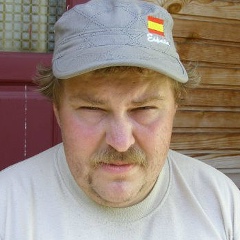Археологические экспедиции, фирменные студенческие практики истфака, я не посещал. Я был «платником», у нас первой опцией для прохождения практики была работа в приёмной комиссии, а археология ограничилась зачётом на первом курсе. Впоследствии я об этом жалел. Друзья пересказывали множество прям приключенческих баек из археологических экспедиций.
На этой неделе я оказался в Гнёздово, что под Смоленском. Это прелюбопытное место, напоминающее английское Эйвбери, городок среди памятников неолита, где я был в апреле. Гнёздово же посёлок, в котором на каждом углу находятся курганы, памятники дохристианской Руси. Курганы относятся к X веку, представляя собой погребения кривичей с явным скандинавским влиянием. Сохранились и следы древнего поселения.
По одной из гипотез, Смоленск изначально располагался именно в Гнёздово, по другой версии, в Гнёздово был другой город, название которого не сохранилось. В любом случае это место было важным торговым пунктом на пути «из варяг в греки». Первое упоминание Смоленска датируется 862 годом, причём Смоленск уже назван «стольным градом» кривичей.
Копать в Гнёздово начали ещё в конце XIX века. С тех пор действуют археологические экспедиции с перерывами лишь на несколько лет. Количество потенциальных объектов для раскопок велико – к некоторым даже не подступались археологи. Я ездил на раскоп кургана, который располагается прям на деревенском участке. А по соседству ещё два. Хозяин участка вознамерился построить на месте кургана баню, а, чтобы добро не пропадало, он решил позвать археологов. Местные относятся к курганам с пиететом. Некоторые считают, что если разворошат курганы, то злые духи проснутся. Однако предрассудки не мешают гнёздовцам брать землю из курганов в своих целях.
Труд археологов энергозатратный и кропотливый. В начале с помощью специальных приборов выясняют конфигурацию курганов (что внутри), а затем делят курганы на сектора и копают в несколько этапов (первый этап – очищают землю от дёрна, затем копают до такой стадии, когда видна непосредственная насыпь кургана, затем аккуратно, слой за слоем идут к кладу). Раньше, в конце XIX века, копали курганы «колодцем», то есть прорывали дырку в центре кургана и пытались добраться до захоронения. Находки какие-либо следует ожидать после нескольких недель постепенной работы с курганом. Рабочий день длится с 8:00 до 16:00, выходной только в воскресенье.
На раскопе трудятся далеко не только профессиональные археологи. В течение лета, когда идут раскопки, приезжают студенты из истфака МГУ и волонтёры. В МГУ это обязательная практика, но есть и ребята из археологического кружка при истфаке. Они лучше подготовлены к раскопкам и работают в экспедиции дольше обычных студентов. Часто приезжают на раскопки волонтёры из-за границы – в основном из Швеции и Германии. Экспедиция проживает на базе отдыха 1950-х годов, похожей на пионерлагерь. Это минутах в семи езды от Гнёздово, куда археологов доставляет автобус. Условия как в приличном хостеле, но со студенческими особенностями. Так, еду готовят сами студенты – каждый день дежурит несколько человек, которые закупаются, готовят еду, моют посуду и так далее. Всего в экспедиции было порядка 50 человек. Атмосфера дружеская, чему способствуют естественные вечерние пьянки.
Многие ребята берут отпуск и ездят в Гнёздово копать. Я сам проникся этой идеей. Осмысленная физическая работа на контрасте с офисом действует успокоительно. Конечно, копать в течение 8 часов – это не очень легко, но после рабочего дня ощущения, как после тяжёлой тренировки, приятная усталость с осознанием того, что сделал полезное дело.
На этой неделе я оказался в Гнёздово, что под Смоленском. Это прелюбопытное место, напоминающее английское Эйвбери, городок среди памятников неолита, где я был в апреле. Гнёздово же посёлок, в котором на каждом углу находятся курганы, памятники дохристианской Руси. Курганы относятся к X веку, представляя собой погребения кривичей с явным скандинавским влиянием. Сохранились и следы древнего поселения.
По одной из гипотез, Смоленск изначально располагался именно в Гнёздово, по другой версии, в Гнёздово был другой город, название которого не сохранилось. В любом случае это место было важным торговым пунктом на пути «из варяг в греки». Первое упоминание Смоленска датируется 862 годом, причём Смоленск уже назван «стольным градом» кривичей.
Копать в Гнёздово начали ещё в конце XIX века. С тех пор действуют археологические экспедиции с перерывами лишь на несколько лет. Количество потенциальных объектов для раскопок велико – к некоторым даже не подступались археологи. Я ездил на раскоп кургана, который располагается прям на деревенском участке. А по соседству ещё два. Хозяин участка вознамерился построить на месте кургана баню, а, чтобы добро не пропадало, он решил позвать археологов. Местные относятся к курганам с пиететом. Некоторые считают, что если разворошат курганы, то злые духи проснутся. Однако предрассудки не мешают гнёздовцам брать землю из курганов в своих целях.
Труд археологов энергозатратный и кропотливый. В начале с помощью специальных приборов выясняют конфигурацию курганов (что внутри), а затем делят курганы на сектора и копают в несколько этапов (первый этап – очищают землю от дёрна, затем копают до такой стадии, когда видна непосредственная насыпь кургана, затем аккуратно, слой за слоем идут к кладу). Раньше, в конце XIX века, копали курганы «колодцем», то есть прорывали дырку в центре кургана и пытались добраться до захоронения. Находки какие-либо следует ожидать после нескольких недель постепенной работы с курганом. Рабочий день длится с 8:00 до 16:00, выходной только в воскресенье.
На раскопе трудятся далеко не только профессиональные археологи. В течение лета, когда идут раскопки, приезжают студенты из истфака МГУ и волонтёры. В МГУ это обязательная практика, но есть и ребята из археологического кружка при истфаке. Они лучше подготовлены к раскопкам и работают в экспедиции дольше обычных студентов. Часто приезжают на раскопки волонтёры из-за границы – в основном из Швеции и Германии. Экспедиция проживает на базе отдыха 1950-х годов, похожей на пионерлагерь. Это минутах в семи езды от Гнёздово, куда археологов доставляет автобус. Условия как в приличном хостеле, но со студенческими особенностями. Так, еду готовят сами студенты – каждый день дежурит несколько человек, которые закупаются, готовят еду, моют посуду и так далее. Всего в экспедиции было порядка 50 человек. Атмосфера дружеская, чему способствуют естественные вечерние пьянки.
Многие ребята берут отпуск и ездят в Гнёздово копать. Я сам проникся этой идеей. Осмысленная физическая работа на контрасте с офисом действует успокоительно. Конечно, копать в течение 8 часов – это не очень легко, но после рабочего дня ощущения, как после тяжёлой тренировки, приятная усталость с осознанием того, что сделал полезное дело.
Archaeological expeditions, branded student practices at the history faculty, I did not attend. I was a “payer”, our first option for internship was to work in the selection committee, and archeology was limited to offsetting in the first year. Subsequently, I regretted it. Friends retold many direct adventure tales from archaeological expeditions.
This week I ended up in Gnezdovo, near Smolensk. This is a curious place, reminiscent of the English Avebury, a town among the Neolithic monuments, where I was in April. Gnezdovo is a village in which at every corner there are barrows, monuments of pre-Christian Russia. The mounds date back to the 10th century, representing the burials of the Krivichi with obvious Scandinavian influence. Traces of the ancient settlement have also been preserved.
According to one hypothesis, Smolensk was originally located in Gnezdovo, according to another version, there was another city in Gnezdovo, the name of which was not preserved. In any case, this place was an important trading point on the way "from the Vikings to the Greeks." The first mention of Smolensk dates back to 862, and Smolensk has already been called the "capital city" of the Krivichi.
Digging in Gnezdovo began at the end of the XIX century. Since then, archaeological expeditions have been operating with interruptions for only a few years. The number of potential sites for excavation is large - some did not even approach archaeologists. I went to the excavation of the mound, which is located directly on the village site. And in the neighborhood two more. The owner of the site set out to build a bathhouse on the site of the mound, and so that the good did not disappear, he decided to call archaeologists. Local belong to the mounds with reverence. Some believe that if mounds are stirred up, then evil spirits will wake up. However, prejudice does not prevent the nest members from taking land from the mounds for their own purposes.
The work of archaeologists is energy-intensive and painstaking. In the beginning, with the help of special devices, the configuration of the mounds is found out (what's inside), and then the mounds are divided into sectors and dug in several stages (the first stage is to clear the land of turf, then dig to a stage where a direct mound of the mound is visible, then gently, a layer after the layer go to the treasure). Earlier, at the end of the 19th century, burial mounds were dug by a "well", that is, they broke a hole in the center of the mound and tried to get to the burial place. Any findings should be expected after several weeks of gradual work with the mound. The working day lasts from 8:00 to 16:00, a day off only on Sunday.
Not only professional archaeologists work at the excavation site. During the summer, when excavations are underway, students come from the history department of Moscow State University and volunteers. This is an obligatory practice at Moscow State University, but there are guys from the archaeological club at the history department. They are better prepared for excavations and work on expeditions longer than ordinary students. Volunteers from abroad often come to the excavation site - mainly from Sweden and Germany. The expedition lives in a recreation center of the 1950s, similar to a pioneer camp. It is a seven-minute drive from Gnezdovo, where archaeologists deliver a bus. Conditions are in a decent hostel, but with student features. So, the students themselves cook the food - every day several people are on duty who buy, prepare food, wash dishes and so on. In total, the expedition had about 50 people. The atmosphere is friendly, which is facilitated by the natural evening booze.
Many guys take a vacation and go to Gnezdovo to dig. I myself was inspired by this idea. Meaningful physical work in contrast to the office is reassuring. Of course, digging for 8 hours is not very easy, but after a working day it feels like after a hard workout, pleasant tiredness with the knowledge that I did a useful job.
This week I ended up in Gnezdovo, near Smolensk. This is a curious place, reminiscent of the English Avebury, a town among the Neolithic monuments, where I was in April. Gnezdovo is a village in which at every corner there are barrows, monuments of pre-Christian Russia. The mounds date back to the 10th century, representing the burials of the Krivichi with obvious Scandinavian influence. Traces of the ancient settlement have also been preserved.
According to one hypothesis, Smolensk was originally located in Gnezdovo, according to another version, there was another city in Gnezdovo, the name of which was not preserved. In any case, this place was an important trading point on the way "from the Vikings to the Greeks." The first mention of Smolensk dates back to 862, and Smolensk has already been called the "capital city" of the Krivichi.
Digging in Gnezdovo began at the end of the XIX century. Since then, archaeological expeditions have been operating with interruptions for only a few years. The number of potential sites for excavation is large - some did not even approach archaeologists. I went to the excavation of the mound, which is located directly on the village site. And in the neighborhood two more. The owner of the site set out to build a bathhouse on the site of the mound, and so that the good did not disappear, he decided to call archaeologists. Local belong to the mounds with reverence. Some believe that if mounds are stirred up, then evil spirits will wake up. However, prejudice does not prevent the nest members from taking land from the mounds for their own purposes.
The work of archaeologists is energy-intensive and painstaking. In the beginning, with the help of special devices, the configuration of the mounds is found out (what's inside), and then the mounds are divided into sectors and dug in several stages (the first stage is to clear the land of turf, then dig to a stage where a direct mound of the mound is visible, then gently, a layer after the layer go to the treasure). Earlier, at the end of the 19th century, burial mounds were dug by a "well", that is, they broke a hole in the center of the mound and tried to get to the burial place. Any findings should be expected after several weeks of gradual work with the mound. The working day lasts from 8:00 to 16:00, a day off only on Sunday.
Not only professional archaeologists work at the excavation site. During the summer, when excavations are underway, students come from the history department of Moscow State University and volunteers. This is an obligatory practice at Moscow State University, but there are guys from the archaeological club at the history department. They are better prepared for excavations and work on expeditions longer than ordinary students. Volunteers from abroad often come to the excavation site - mainly from Sweden and Germany. The expedition lives in a recreation center of the 1950s, similar to a pioneer camp. It is a seven-minute drive from Gnezdovo, where archaeologists deliver a bus. Conditions are in a decent hostel, but with student features. So, the students themselves cook the food - every day several people are on duty who buy, prepare food, wash dishes and so on. In total, the expedition had about 50 people. The atmosphere is friendly, which is facilitated by the natural evening booze.
Many guys take a vacation and go to Gnezdovo to dig. I myself was inspired by this idea. Meaningful physical work in contrast to the office is reassuring. Of course, digging for 8 hours is not very easy, but after a working day it feels like after a hard workout, pleasant tiredness with the knowledge that I did a useful job.





У записи 12 лайков,
0 репостов,
335 просмотров.
0 репостов,
335 просмотров.
Эту запись оставил(а) на своей стене Сергей Лунёв

































